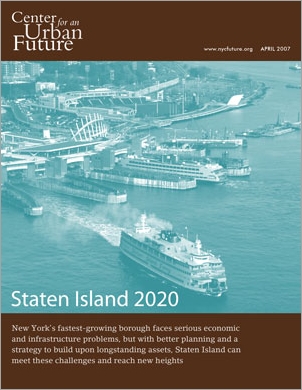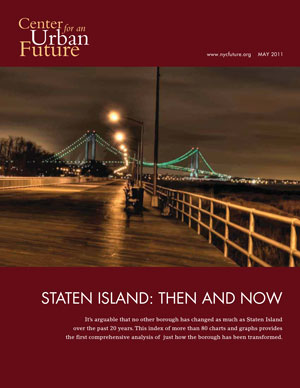Click here to read the full report (PDF).
UPDATE: One year later, CUF's Staten Island 2020 report is gaining momentum
In April 2007, the Center for an Urban Future released "Staten Island 2020", a report commissioned by the Staten Island Economic Development Corporation (SIEDC) that examined options and made recommendations about how to grow and diversify the economy of the city’s fastest-growing borough. The Center's agenda for Staten Island began with broad "Principles for Growth"—such as "Staten Island needs to plan. Period."—before focusing in on specific action steps, such as redeveloping the former U.S. Gypsum site on the North Shore waterfront. It was the hope of SIEDC that a document by an independent, off-island group would allow policymakers to judge proposals on their merits, rather than on who was making them.
A little more than a year later, that hope seems to be coming to fruition. Each of the island's 11 elected officials has stepped up to champion at least one of the report’s 14 recommendations, from upgrading the St. George ferry terminal to supporting the island’s growing population of minority and immigrant entrepreneurs, a project SIEDC itself is carrying out. The corporation has also hired a full-time SI 2020 project manager to push for progress on all of the recommendations.
In "Staten Island 2020," the Center identified a set of endemic problems in the borough that stemmed from its traditional aversion to planning: worsening traffic congestion and a fragmented mass transit system, too-slow development of badly needed new schools and senior housing, slipshod development in stately neighborhoods and an ill-considered blanket low-density zoning that imperils potential growth in places like St. George and Stapleton, which at last seem poised for a revival.
Spurred in part by SI 2020, Staten Island's three-member City Council delegation—Republicans James Oddo and Vincent Ignizio, and Democrat Michael McMahon—have introduced legislation that would require a master plan for each of the five boroughs. The bill has 28 sponsors, which more or less assures it will have the 26 votes it needs to pass. But the Bloomberg Administration, which opposes the proposal on the grounds that the city's current planning process is sufficient, has so far succeeded in keeping it bottled up in committee. The bill's supporters continue to seek enough support to force a vote; the recent endorsement of Bronx Borough President Adolpho Carrion offers new grounds for hope.
While the fight over the master plan bill continues, a St. George Special District Rezoning Plan, drawn up by the Department of City Planning at the request of Staten Island officials, has begun to make its way through the public review process. The plan encompasses a number of SI2020 recommendations, setting the stage for a critical mass of growth around the Staten Island Ferry and other key transportation hubs, with the goal of building a 24-hour community that would include well-attended cultural attractions, lively streets and quality retail. If approved, the proposed rezoning should help jump-start St. George Station, a proposed mixed-use development to the west of the St. George Ferry terminal that would include 1,070 residential units and 57,000 square feet of retail space over what is now commuter parking lots.
A key recommendation of the report is to tap the economic potential of the Staten Island Ferry. To that end, the New York City Economic Development Corporation has hired Jeanne Giordano Ltd, the consulting firm that turned Grand Central Terminal from a semi-seedy way station into an urban destination, to take on the overdue task of overseeing retail development at the St. George and Whitehall Ferry Terminals, which have 36,000 square feet of valuable but mostly vacant retail space. Meanwhile, the city's Department of Information and Technology has taken over a promising effort to provide WiFi service on the ferry, first piloted by two private phone service providers.
The Center also urged Staten Island to explore ways to better support a growing population of minority and immigrant entrepreneurs. SIEDC responded by setting up a series of outreach events in its immigrant and minority entrepreneur program, the first of which took place in May. The event focused on financing and credit history and was conducted by the New York Association for New Americans.
The redevelopment of the former U.S. Gypsum site on Richmond Terrace has begun as well. Atlantic Salt, the current owner of the site, has begun clearing the property of its derelict structures. The company ultimately plans to build a much-needed retail center there. Other activity relating to the redevelopment of Staten Island's extensive but underutilized waterfront is proceeding as well, including the Center’s recommendation of staging occasional concerts and other high-profile events to draw tourist traffic to the site.
While the maritime services sector has been a big part of Staten Island’s past, SI2020 found that it has great potential to support the borough’s economic future as well and urged SIEDC and other local stakeholders to take actions to support growth and expansion within the sector. The services provided by the island’s maritime businesses, which do everything from chandlering to dry dock repair work, are indispensable to the thriving Port of New York, which is enjoying record volume of waterborne commerce and is projected by the Port Authority of New York/New Jersey to continue growing through 2060. At SIEDC's annual economic development conference in April, dozens of local maritime businesses took the first steps toward forming a professional association that would help the local economy by working to keep adding well-paying, port-related jobs.



